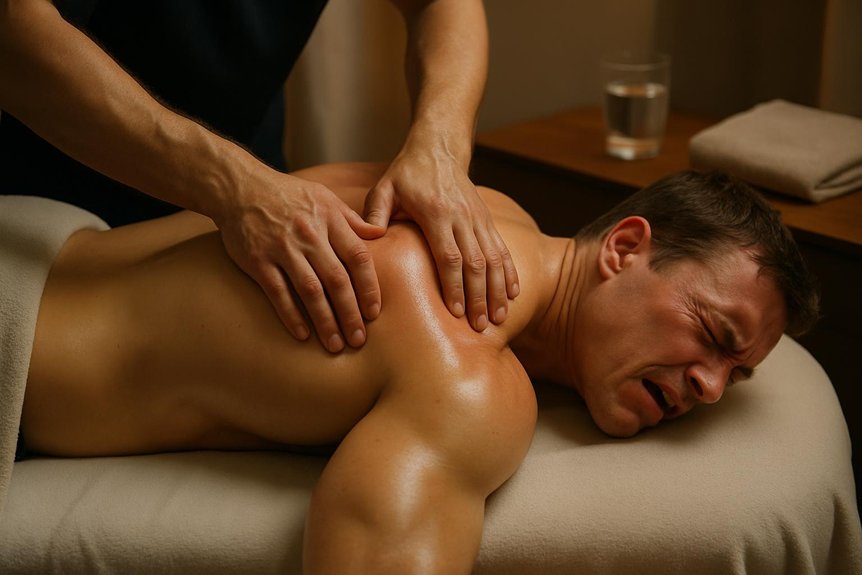This type of massage does not make a healthy person ill, but it can provoke short-lived, normal responses. Sustained pressure can release myofascial adhesions, shift the nervous system, and improve circulation. Temporary soreness, fatigue, headache, thirst, mild redness, or digestive gurgling may occur and usually resolve within 24–48 hours with hydration and gentle movement. Red flags include escalating pain, swelling, numbness, fever, chest pain, or spreading warmth. Certain conditions require modified techniques and informed consent, which skilled therapists provide; more guidance follows.
What It Does to Your Body

A deep tissue massage applies sustained, well-aligned pressure to specific layers of muscle, fascia, and tendon to reduce excessive tone, release myofascial adhesions, and improve tissue glide. When delivered by Spa & Massage therapists, strokes track along fiber direction to normalize sarcomere length, enhance circulation, and calm peripheral nociceptors.
Targeted shear and compression restore slide between fascial planes, easing restricted shoulders, hips, and spine. Slow pacing invites parasympathetic shift—breath lengthens, heart rate steadies, and guarded tissue softens.
Joint range often improves as capsules and retinacula experience gentle mobilization. Lymphatic return is supported with proximal-to-distal sequencing. Pressure is always negotiated; therapists adjust depth to honor comfort while reaching therapeutic layers.
Clients leave with clearer body awareness and steadier, pain-free movement. Intensive tissue massage offers benefits for muscle and fascia, including improved mobility and reduced tension through skilled manipulation of deeper layers.
Why You Might Feel Unwell After a Massage
After deep tissue work, it is common to experience transient soreness, mild fatigue, headache, or thirst as muscle fibers recover and autonomic tone shifts—responses our therapists at Spa & Massage explain as normal.
These effects usually resolve within 24–48 hours with hydration, light movement, and rest, which our clinics routinely recommend as aftercare.
However, clients should seek prompt advice if pain is severe, swelling or numbness develops, fever occurs, or symptoms persist beyond two days, as this may indicate an adverse reaction or an unrelated medical issue.
Normal Post-Massage Responses
Occasional post-massage discomfort can be a normal, short-lived response to therapeutic pressure and tissue manipulation.
After deep tissue work, muscles that were tightened may exhibit mild soreness, similar to delayed-onset muscle soreness. This reflects micro-level tissue stress, transient inflammation, and increased local circulation.
Some people notice fatigue, light thirst, or a gentle emotional release as the nervous system shifts from sympathetic arousal toward parasympathetic rest.
At Spa & Massage in London, therapists explain these responses before treatment and tailor pressure to the client’s goals.
They recommend slow hydration, a warm shower, and unhurried movement to promote lymphatic return and reduce stiffness.
Normal responses typically ease within 24–48 hours.
Clients are encouraged to communicate sensations during sessions so therapists can adjust techniques, pacing, and breath cues to keep the experience therapeutic, intimate, and confidently safe.
When to Seek Help
When might post-massage sensations signal more than normal adaptation? Seek help if pain localises sharply, intensifies after 24–48 hours, or limits weight-bearing or range of motion—signs that muscle fibres, fascia, or a joint capsule may be irritated rather than simply metabolically sore.
Red flags include new numbness, tingling, or weakness (possible nerve compression), chest pain or shortness of breath, fever, rash, or calf swelling and heat. Persistent headache with neck stiffness warrants review.
At Spa & Massage, therapists advise contacting the clinic if bruising spreads, swelling increases, or if dizziness persists beyond a few hours despite hydration and gentle movement.
Clients with anticoagulant use, diabetes, osteoporosis, or recent injury should call sooner. Our clinicians can adjust pressure, modify techniques, and refer to a GP or urgent care when appropriate.
Normal Post-Massage Reactions vs. Warning Signs
After deep tissue work, transient soreness, mild fatigue, light bruising, and temporary stiffness in targeted muscle groups are common, reflecting microtrauma and local inflammatory repair.
Red flags include escalating pain unrelieved by rest, fever, spreading redness or warmth, new neurological changes (numbness, weakness), chest pain, or calf swelling—signs that warrant prompt medical advice and notifying the clinic.
At Spa & Massage, therapists recommend hydration, gentle mobility, heat for stiffness, ice for focal tenderness, and monitoring symptoms for 24–48 hours, adjusting future session pressure and techniques to the client’s response.
Common, Harmless Reactions
A clear understanding of normal post-massage responses helps clients distinguish harmless, short-lived effects from warning signs that warrant attention. After deep tissue work, transient muscle soreness, tenderness at pressure sites, and a “worked-out” heaviness are common as myofascial adhesions are mobilised and nociceptors adapt.
Mild fatigue, thirst, or lightheadedness can arise as parasympathetic tone increases and peripheral circulation shifts. Brief skin warmth or redness reflects vasodilation.
Some clients notice increased urination or subtle digestive gurgling as autonomic balance resets.
At Spa & Massage, therapists advise gentle movement, unhurried breathing, hydration, and a warm shower to ease recovery. Applying a light, unscented lotion or arnica gel to non-broken skin may reduce local soreness.
Most reactions peak within 24 hours and settle by 48, leaving tissues softer, freer, and comfortably responsive.
When to Seek Help
Knowing what feels normal helps clients notice what does not. After a massage, mild soreness, light fatigue, and transient tenderness over worked muscle bands are expected. Hydration and rest usually ease these within 24–48 hours.
Spa & Massage therapists advise seeking help if pain escalates rather than softens, or if movement becomes limited due to sharp, focal pain suggesting strain. Red, spreading warmth, fever, or chills may indicate inflammation or infection and warrants prompt medical advice.
New numbness, tingling, or weakness could signal nerve irritation. Chest pain, shortness of breath, calf swelling with heat, or sudden, severe headache are urgent red flags. Persistent dark urine, dizziness, or confusion after intense pressure are also concerning.
Clients can contact Spa & Massage for clinical guidance and appropriate referral.
How to Self-Manage
While most deep tissue sessions conclude without complication, self-management starts with recognising what the body is doing physiologically. Mild post-treatment soreness, warmth, and transient fatigue reflect microtearing in muscle fibres, local vasodilation, and autonomic downshift. These settle within 24–48 hours.
Spa & Massage therapists advise gentle mobility, diaphragmatic breathing, and hydration aligned with thirst; warm showers and light protein intake support tissue repair.
Warning signs differ: escalating, sharp pain; numbness or tingling following a dermatomal pattern; joint swelling; fever; shortness of breath; or new, spreading rash. These warrant medical review.
Persistent headache unrelieved by fluids, or chest pain, is urgent.
Clients can self-check by comparing side-to-side strength, evaluating range without pain provocation, and monitoring skin temperature. If uncertain, Spa & Massage encourages prompt contact for tailored aftercare.
Who Should Avoid or Modify This Massage Therapy
When is it not the right choice? It should be avoided with acute infections, fever, or systemic inflammation; forceful work may transiently increase circulation and aggravate malaise.
Individuals with uncontrolled hypertension, severe osteoporosis, clotting disorders, or on anticoagulants risk bruising or thrombus mobilization. Avoid direct pressure over varicose veins, active rashes, open wounds, or recent fractures.
After surgery, cancer treatment, or recent DVT, clearance is essential. Pregnancy requires modified positioning and lighter pressure, avoiding deep abdominal work.
Neuropathy, advanced diabetes, or Ehlers–Danlos syndrome call for gentle, graded techniques to respect tissue integrity and nerve sensitivity.
At Spa & Massage, therapists adapt pressure to the client’s breath, pain scale, and tissue response, prioritising consent, clear communication, and comfort in every London clinic.
How Our Therapists Minimise Post-Treatment Discomfort
Understanding who may need to avoid or modify deep tissue work sets the stage for safer care. From that foundation, Spa & Massage therapists focus on reducing post-treatment soreness through calibrated technique and informed aftercare.
They pace pressure gradually, warming superficial fascia before engaging deeper layers, then targeting specific myofascial restrictions rather than sweeping force. Communication guides dosage: therapists track breath, tissue temperature, and muscle guarding to avoid nociceptive overload.
They favour slow, sustained compressions, cross-fibre friction only where adhesions are palpable, and precise stripping along fibre direction for the trapezius, quadratus lumborum, gluteals, and calves.
Joint articulation and gentle nerve glides disperse hypertonicity without provoking inflammation.
Sessions end with guided diaphragmatic breaths and light effleurage to restore parasympathetic tone, supporting comfort once clients step back into London life.
Hydration, Nutrition, and Aftercare We Recommend

Although deep tissue work primarily targets musculoskeletal structures, ideal recovery depends on systemic support—hydration, nutrient intake, and structured aftercare.
At Spa & Massage, therapists encourage clients to drink 500–750 ml of water over the next few hours to support plasma volume and lymphatic clearance, limiting alcohol and excess caffeine.
A light, protein-forward meal—such as eggs, legumes, or fish—paired with complex carbohydrates and potassium-rich produce aids collagen repair and glycogen replenishment.
They recommend gentle mobility within pain-free ranges, a warm shower, and, if soreness lingers, 10–15 minutes of localized heat.
For delayed soreness, clients may alternate heat and cool packs.
Sleep is prioritized; a supportive pillow positioning the cervical spine neutral helps.
Many choose our fragrance-free grapeseed oil at home for self-massage, following therapist-taught strokes.
When to Seek Medical Advice After a Massage
In the hours following deep tissue work, most clients experience mild, short-lived soreness. However, certain signs warrant prompt medical review.
Red-flag symptoms include sharp, escalating pain unresponsive to rest or simple analgesics; new numbness, tingling, or weakness in a limb; severe headache with neck stiffness; chest pain, shortness of breath, or palpitations; fever above 38°C; rapidly spreading redness, warmth, or swelling over a treated area; calf pain with marked tenderness or unilateral swelling; dark urine or profound fatigue suggesting excessive muscle breakdown; and persistent dizziness or fainting.
At Spa & Massage, therapists monitor for adverse responses and encourage clients to report concerns within 24–48 hours. Those on anticoagulants, with clotting disorders, diabetes with neuropathy, recent surgery, or pregnancy should seek advice sooner if symptoms emerge.
Alternatives and Gentler Options at Spa & Massage
Some clients prefer a lighter approach after noting soreness or heightened sensitivity, and Spa & Massage offers gentler pathways without sacrificing therapeutic intent.
Therapists may recommend Swedish-style pressure, slow myofascial glides, and joint mobilisations that lengthen tissue without provoking reflex guarding. Aromatherapy massage—using hypoallergenic carrier oils—supports parasympathetic downshift, easing breath and reducing perceived pain.
For those fatigued or inflamed, reflexology and focused scalp, face, and neck work modulate autonomic tone while avoiding overloading tender muscle groups.
Pregnancy massage uses side-lying positioning, supported bolsters, and lymph-aware strokes to reduce swelling and soothe low-back tension.
Clients are encouraged to communicate pressure preferences each session; therapists adjust tempo, stroke length, and depth in real time.
Hydration, gentle stretching, and paced recovery are advised post-treatment.
Conclusion
In the end, the question lingers: can intensive tissue massage make someone ill—or simply reveal what the body needs? Evidence suggests most reactions are transient—mechanical load on fascia, transient inflammatory mediators, autonomic downshift—yet pressure mismatch or contraindications can tip the balance. With careful screening, graded technique, and targeted aftercare—hydration, light movement, protein, sleep—clients usually feel better, not worse. Still, the line between normal soreness and warning signs remains. Listeners pause—will their next session heal or hinder? The answer lies in tailoring.



